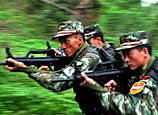
URUMQI, July 5 (Xinhua) -- More than one week after rioters killed 24 people at Lukqun Township in northwest China's Xinjiang Uygur Autonomous Region, the charred walls of a police station still serve as a painful reminder of that violent morning on June 26.
What happened on that bloody morning? Who were the rioters? What have caused a series of violent terrorist attacks in Xinjiang?
Over the past week, Xinhua reporters conducted extensive interviews with victims, witnesses, officials and experts to uncover more details of the terror attacks.
BLOODY SLAUGHTER
Lukqun Township in Shanshan County is well known for its abundant melon and grape production. The police station, government building and the office building of the special patrol squadron are located from west to east along the township's main artery, with stores dotting both sides of the road.
At this time of year, local people usually start their day early in order to dodge the temperatures that begin to soar around noon. At dawn of June 26, about 1,000 workers gathered near a crossroad in the town center, waiting to pick and transport fruit.
No one could have known what was about to happen. Around 6 a.m., truck driver Liu Fei from Korla City in southern Xinjiang was awakened by noise outside. Through his windows, he saw flames spurting from the police station across the road and a chaotic scene on the street crowded with people.
Shortly after, he saw a group of people run out of the police station, wielding long knives. They jumped onto a motorized tricycle and piled into a black Volkswagen Santana sedan and rushed toward the township government building, followed by another group of shouting young people, some of whom were wearing masks.
What shocked Liu most was a human head in a pool of blood in the middle of the street.
The violent terrorist attack was the most severe since the July 5, 2009 riots that resulted in 197 deaths in Xinjiang's capital of Urumqi.
The police station was only the rioters' first target. They attacked the office building of the special patrol squadron, the township government building, a construction site, a private store and a beauty saloon. They also set fire to multiple cars and motorcycles.
Abulimit, a retired teacher who used to be up early, on that day was killed while trying to stop the rioters from attacking a pedestrian with their wielding long knives.
A security guard also saw the atrocities and alerted police. He was also killed while trying to stop the rioters.
The rioters also attacked a construction site, killing a number of workers there.
According to public security authorities, 24 people, including two females, were killed in the attack. Of the victims, 16 were ethnic Uygurs and eight were of Han ethnic. The attacks also left 21 others injured.
On the afternoon when Xinhua reporters arrived at Lukqun, the wreckage of charred or damaged cars, police vehicles and motorcycles could be seen along the road and in the yards outside the targeted buildings.
The shrouded bodies of some victims were lain in the backyard of the police station. A police officer told reporters that at least five victims were beheaded.
"The bodies of the police officers and civilians were all gathered here to be taken away, while the rioters' bodies were put in another place. We must not lay their bodies together," the police officer said, bursting into tears.
The terror attack shocked local communities, as the region of Turpan Prefecture that administers Shanshan County has witnessed fast development in recent years, and local people live a relatively well-off life.
"We are living a paradise-like life. But on that day, I saw the scenes of hell," said Suleyman, an ethnic Uygur who has lived in the township for more than three decades.
 |
















 People enjoy time at old teahouse in Kashgar, NW China's Xinjiang
People enjoy time at old teahouse in Kashgar, NW China's Xinjiang


![]()
